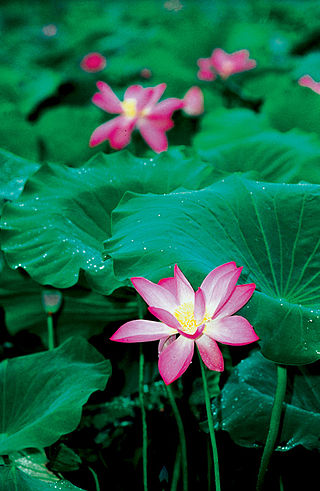
Brachychiton is a genus of 31 species of trees and large shrubs, native to Australia and New Guinea. Fossils from New South Wales and New Zealand are estimated to be 50 million years old, corresponding to the Paleogene.

Doryanthes excelsa, commonly known as the gymea lily, is a flowering plant in the family Doryanthaceae that is endemic to coastal areas of New South Wales near Sydney. It has sword-like leaves more than 1 metre (3 ft) long and it grows a flower spike up to 6 metres (20 ft) high. The apex of the spike bears a large cluster of bright red flowers, each 10 centimetres (4 in) across. Its common name is derived from the name given to the plant by the indigenous [Dharawal] people. The Sydney suburbs of Gymea and Gymea Bay are named after the lily.

Brachychiton acerifolius is a large tree of the family Malvaceae endemic to tropical and subtropical regions on the east coast of Australia. It is famous for the bright red bell-shaped flowers that often cover the whole tree when it is leafless. It is commonly known as the flame tree, Illawarra flame tree, lacebark tree, or kurrajong.

Brachychiton rupestris is a tree in the family Malvaceae, endemic to Queensland, Australia. Described by Sir Thomas Mitchell and John Lindley in 1848, it earned its name from its bulbous trunk, which can be up to 3.5 metres (11 ft) in diameter at breast height (DBH). Reaching around 10–25 metres (33–82 ft) high, the Queensland bottle tree is deciduous, losing its leaves seasonally, between September and December. The leaves are simple or divided, with one or more narrow leaf blades up to 11 centimetres (4 in) long and 2 centimetres (0.8 in) wide. Cream-coloured flowers appear from September to November, and are followed by woody, boat-shaped follicles that ripen from November to May. No subspecies are recognised.

Brachychiton populneus, commonly known as the kurrajong, is a small to medium-sized tree found naturally in Australia in a diversity of habitats from wetter coastal districts to semi-arid interiors of Victoria, New South Wales and Queensland. Carrejun and carrejan were the indigenous names of trees in the foothills of the Blue Mountains near Sydney, and the bark was used for twine and fishing lines. The extended trunk is a water storage device for survival in a warm dry climate. The bell-shaped flowers are variable in colour while the leaves vary considerably in shape. The leaves are either simple and pointed, or may be 3–9 lobed. Saplings grow from a drought and fire resistant tap-rooted tuber.

This is a list of plants commonly found in Kakadu National Park, Northern Territory of Australia. Where known, common names are given in English and in Gun-djeihmi, a commonly spoken indigenous language in the area, are given in parentheses.

Corymbia terminalis, also known as tjuta, joolta, bloodwood, desert bloodwood, plains bloodwood, northern bloodwood, western bloodwood or inland bloodwood, is a species of small to medium-sized tree, rarely a mallee that is endemic to Australia. It has rough, tessellated bark on some or all of the trunk, sometimes also on the larger branches, smooth white to cream-coloured bark above, lance-shaped adult leaves, flower buds in groups of seven, white flowers and urn-shaped fruit.

Brachychiton gregorii, commonly known as the desert kurrajong, is a small tree of the genus Brachychiton found in northern and western Australia. It was originally classified in the family Sterculiaceae, which is now within Malvaceae.

Persoonia falcata, commonly known as the wild pear, is a shrub native to northern Australia.
Brachychiton compactus is a tree of the genus Brachychiton found in northeastern Australia. It is only found in the vicinity of Proserpine in Central Queensland.
Brachychiton spectabilis is a tree of the genus Brachychiton found in northern Australia. It was described by Gordon Guymer in 1988.
Brachychiton multicaulis is a tree of the genus Brachychiton found in northern Australia. It was described in 1988.
Brachychiton acuminatus is a tree of the genus Brachychiton found in northwestern Australia. It was described in 1988.
Brachychiton obtusilobus is a tree of the genus Brachychiton native to Cape Range National Park in Western Australia. It was described in 1988.
Brachychiton grandiflorus is a tree of the genus Brachychiton native to the Cape York Peninsula in Queensland, Australia. It was described in 1988.
Brachychiton albidus is a tree of the genus Brachychiton native to Queensland, Australia. It was described in 1988.
Brachychiton fitzgeraldianus is a tree of the genus Brachychiton found in northwestern Australia. It was described in 1988.
Brachychiton tridentatus, locally known as Sentry Bottle Tree, is a tree of the genus Brachychiton found in northwestern Australia. It was described in 1988.
Brachychiton xanthophyllus is a tree of the genus Brachychiton found in northwestern Australia. It was described in 1988.

Brachychiton viscidulus is a plant in the Malvaceae family, native to Western Australia.









